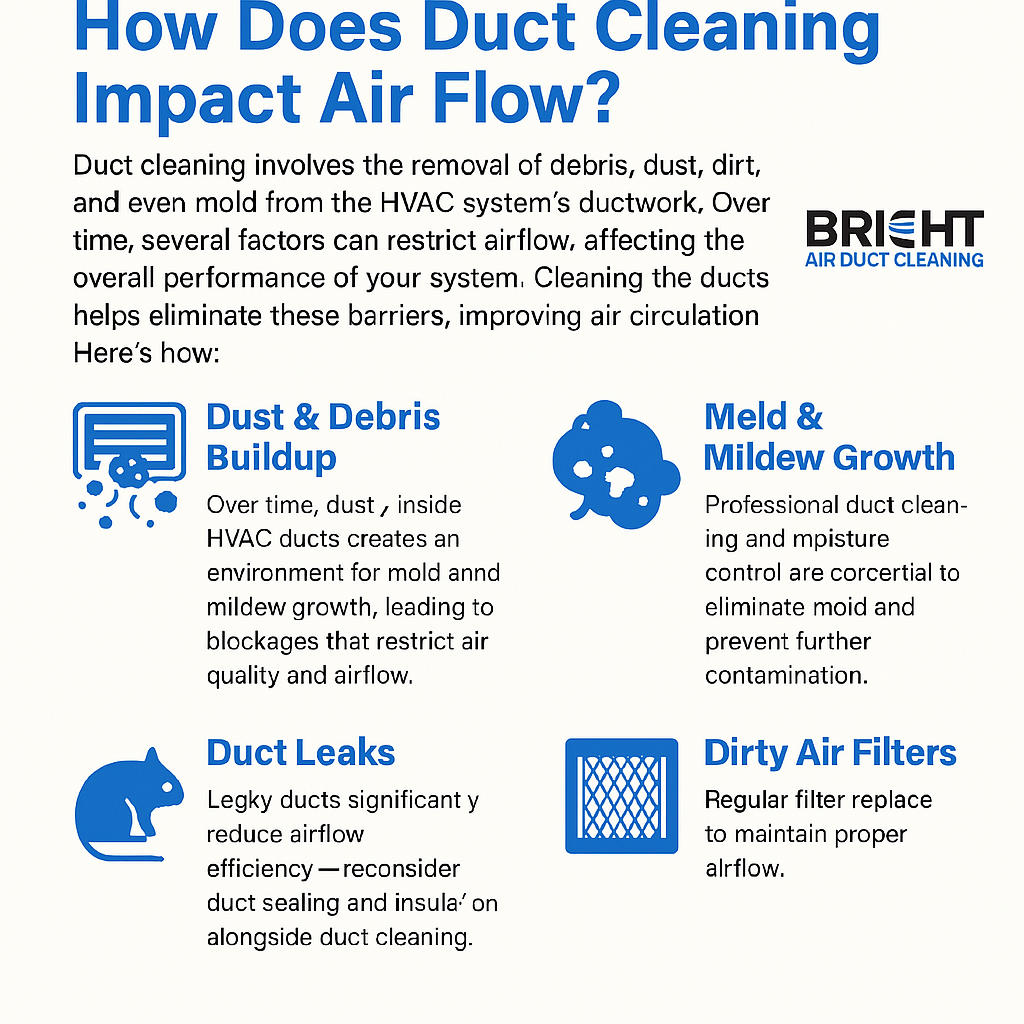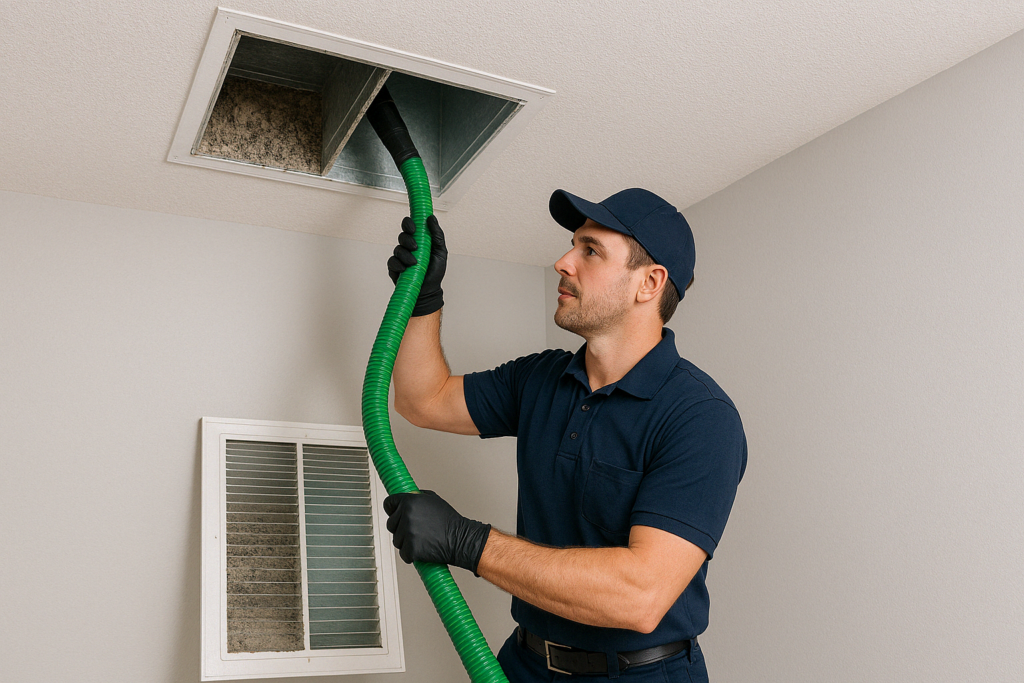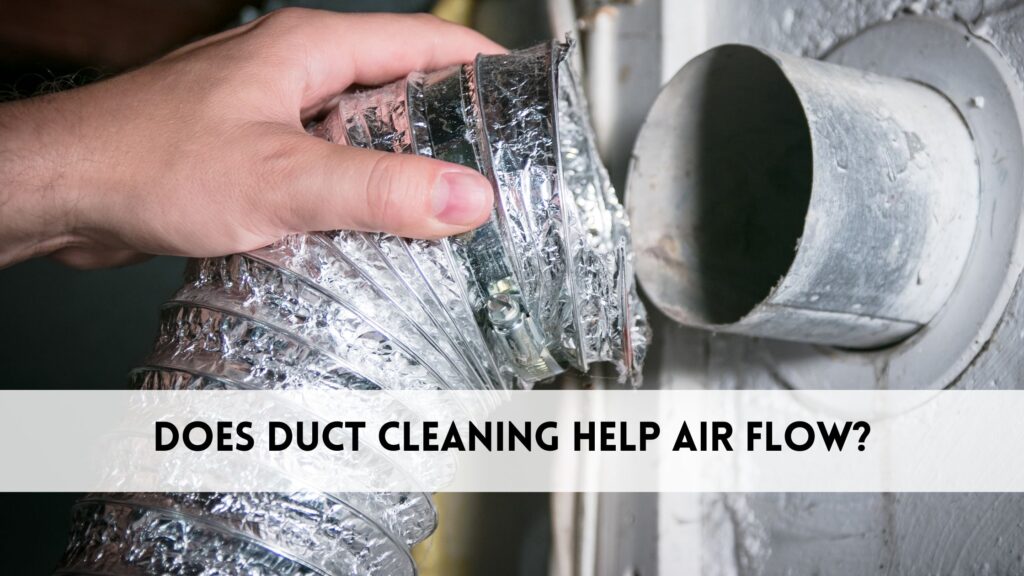Maintaining a clean and efficient HVAC system is crucial for indoor air quality and energy efficiency. Over time, dust, debris, pet dander, and even mold can accumulate in air ducts, potentially impacting airflow and overall system performance. Homeowners often wonder, Does duct cleaning help air flow? While removing contaminants from air ducts can improve air quality, many are unsure whether it significantly enhances airflow or if alternative maintenance practices yield better results.
HVAC efficiency depends on multiple factors, including duct cleanliness, filter condition, air leaks, and system design. While clogged ducts can restrict airflow, simply cleaning them may not always lead to noticeable improvements. Understanding when duct cleaning is necessary and when it isn’t can help homeowners make informed decisions about their HVAC system maintenance.
In this article, we’ll explore how duct cleaning impacts airflow, its key benefits and drawbacks, and alternative ways to optimize your HVAC system for maximum efficiency and improved air circulation.
Does duct cleaning help air flow? How?
Yes, duct cleaning can improve airflow, but its effectiveness depends on the condition of your HVAC system. Here’s how it impacts airflow:
Removes Airflow Blockages
Over time, dust, dirt, pet dander, and debris accumulate inside air ducts, restricting airflow and reducing HVAC efficiency. These blockages can lead to uneven temperature distribution and increased energy consumption as the system struggles to push air through. Duct cleaning removes these obstructions, allowing air to flow more freely throughout the system. By maintaining clean ducts, homeowners can ensure that conditioned air reaches all rooms efficiently, improving comfort levels and preventing unnecessary strain on the HVAC unit.
Reduces Strain on HVAC System
A clogged duct system forces the HVAC unit to work harder to push air, leading to higher energy consumption and possible system wear and tear. Restricted airflow results in uneven heating or cooling, which can cause discomfort and increase electricity bills. By removing accumulated dust and debris, duct cleaning helps the HVAC system operate at peak efficiency, reducing stress on critical components. A system with unobstructed airflow not only performs better but also enjoys an extended lifespan and lower maintenance costs.
Enhances Indoor Air Quality
Air ducts can harbor dust, allergens, mold spores, and bacteria, which circulate throughout the home every time the HVAC system runs. Poor air quality can trigger allergies, asthma, and respiratory issues. Duct cleaning removes these harmful contaminants, promoting a healthier indoor environment with fresher, cleaner air. While regular filter changes are crucial, cleaning ducts ensures that deep-seated pollutants are eliminated, making the air safer to breathe, particularly for individuals with allergies, pets, or pre-existing respiratory conditions.
Improves Air Circulation in High-Dust Environments
Homes or commercial spaces with excessive dust buildup, pet hair, or mold growth may experience reduced airflow and poor ventilation. Duct cleaning helps remove these contaminants, restoring proper circulation and balancing indoor temperatures. In high-dust environments such as construction zones or older buildings, cleaning the ducts can significantly enhance airflow efficiency. By ensuring unobstructed air pathways, HVAC systems can distribute conditioned air evenly, preventing hot and cold spots and creating a more comfortable living or working space.
May Not Always Be Necessary
Although duct cleaning can enhance airflow, it isn’t always required. If your HVAC system is well-maintained with no visible dust buildup, mold, or blockages, duct cleaning may have minimal impact. Instead, routine filter changes, sealing leaks, and system inspections play a more crucial role in airflow efficiency. HVAC professionals recommend assessing the actual condition of the ducts before scheduling a cleaning. In many cases, preventive maintenance such as air vent cleaning and checking for leaks offers better long-term results.

How Does Duct Cleaning Impact Air Flow?
Duct cleaning involves the removal of debris, dust, dirt, and even mold from the HVAC system’s ductwork. Over time, several factors can restrict airflow, affecting the overall performance of your system. Cleaning the ducts helps eliminate these barriers, improving air circulation and efficiency. Here’s how:
Dust & Debris Buildup
Over time, dust, pet dander, and dirt accumulate inside your home’s ductwork, leading to blockages that restrict airflow. When ducts become clogged, conditioned air struggles to circulate efficiently, resulting in poor ventilation and uneven temperature distribution across rooms. This not only reduces HVAC efficiency but also increases energy consumption, forcing the system to work harder to maintain indoor comfort.
Accumulated dust can also aggravate allergies and respiratory conditions, making air quality a concern. Regular duct cleaning removes this buildup, allowing air to flow freely and ensuring optimal HVAC performance. While duct cleaning helps, homeowners should also routinely replace air filters and keep vents clear to maximize airflow and maintain consistent indoor temperatures.
Mold & Mildew Growth
Moisture buildup inside HVAC ducts creates the ideal environment for mold and mildew growth, which can severely impact air quality and airflow. As mold spores spread through the ventilation system, they compromise respiratory health, triggering allergies and other breathing issues. Mold also creates musty odors and can damage the ductwork, further obstructing airflow.
If left unchecked, mold growth can reduce HVAC efficiency, forcing the system to work harder. Professional duct cleaning and moisture control are essential to eliminating mold and preventing further contamination. Additionally, ensuring proper ventilation, using dehumidifiers, and regularly inspecting ductwork can help keep moisture levels in check, reducing the likelihood of mold development and maintaining healthy indoor air circulation.
Pest Infestations
Pests such as rodents, insects, and small animals can enter your ductwork, creating nests and leaving behind droppings, fur, and debris that block airflow. These obstructions disrupt ventilation, leading to uneven heating and cooling throughout your home. Pest infestations not only compromise HVAC efficiency but also pose health risks, as their waste contains allergens and harmful bacteria that circulate through the air.
Additionally, pests may chew through duct linings, causing leaks that further reduce airflow and increase energy costs. Regular HVAC inspections and duct cleanings help detect and prevent infestations before they escalate. Sealing entry points, keeping the system well-maintained, and scheduling professional pest control when needed can further protect airflow quality and system efficiency.
Duct Leaks
Leaky ducts allow conditioned air to escape before it reaches its intended destination, significantly reducing airflow efficiency. Even if the ducts are clean, leaks cause the HVAC system to work harder, leading to higher energy bills and inconsistent indoor temperatures. Common causes of duct leaks include poor installation, aging ductwork, and physical damage from pests or external pressure.
To maximize airflow and HVAC efficiency, homeowners should consider duct sealing and insulation alongside duct cleaning. Using a professional duct inspection service can help identify leaks that may not be visible. Properly sealed ducts ensure that air flows smoothly and reaches every part of your home, reducing energy waste and improving overall climate control.
Dirty Air Filters
Even if your ducts are clean, clogged air filters can restrict airflow and reduce HVAC system performance. Air filters trap dust, pet dander, pollen, and other airborne particles, preventing them from circulating indoors. However, when filters become overly dirty, they block air movement, making it difficult for the HVAC system to push air through the vents.
This results in poor ventilation, uneven temperatures, and higher energy consumption. To maintain proper airflow, homeowners should replace or clean air filters every 1-3 months, depending on usage and environmental factors. Using high-efficiency air filters and regularly checking for dirt buildup can improve indoor air quality, support smooth airflow, and extend the lifespan of the HVAC system.

Benefits of Duct Cleaning for Air Flow
Duct cleaning offers several advantages contributing to better airflow, improved HVAC efficiency, and healthier indoor air quality. When performed correctly, it can prevent blockages, enhance energy efficiency, and promote even air distribution throughout your home or office.
Enhanced HVAC Efficiency
A clean duct system allows air to move freely without obstruction, reducing the workload on your HVAC system. This results in:
- Lower system strain – When airflow is unrestricted, your heating and cooling unit operates smoothly without overworking itself.
- Faster temperature adjustments – Clean ducts ensure that conditioned air reaches every room efficiently, helping your HVAC system maintain the desired temperature quickly.
- Extended HVAC lifespan – Since the system isn’t forced to work harder than necessary, its components experience less wear and tear, leading to a longer operational life.
A well-maintained duct system improves efficiency, reducing the likelihood of costly repairs and increasing overall system longevity.
Better Indoor Air Quality
Air ducts act as a circulatory system for your home’s air, constantly recirculating particles. Without cleaning, contaminants like dust, pollen, pet dander, mold spores, and bacteria accumulate and circulate throughout the space. Cleaning the ducts contributes to:
- Healthier indoor air – Eliminating airborne pollutants improves breathing conditions for individuals with allergies, asthma, or respiratory sensitivities.
- Odor reduction – Musty odors from dust, mold, and mildew trapped in ducts disappear when ducts are properly cleaned.
- Reduced accumulation of allergens – Regular cleaning prevents allergen buildup, promoting cleaner and fresher indoor air.
Improving air quality is especially beneficial in homes with pets, smokers, or individuals prone to allergies.
Reduced Energy Costs
Restricted airflow forces the HVAC system to consume more energy as it struggles to push air through clogged ducts. Clean air ducts contribute to:
- Lower energy consumption – When air moves efficiently, less energy is required to maintain optimal temperatures.
- Reduced utility bills – Improved airflow prevents HVAC inefficiencies, leading to noticeable savings on electricity costs.
- Better thermostat performance – The HVAC system reaches the set temperature faster, reducing unnecessary energy usage.
According to the U.S. Department of Energy, homeowners can save up to 20% on energy costs by ensuring proper airflow and reducing HVAC strain.
Even Air Distribution
Blocked ducts disrupt the airflow balance, leading to hot and cold spots in different areas of your home. Cleaning your air ducts ensures:
- Consistent temperature control – With clean ducts, warm and cool air is evenly distributed across all rooms.
- Better ventilation – Fresh air circulates more efficiently, reducing stagnant or poorly ventilated areas.
- Increased comfort – You won’t have to constantly adjust the thermostat to compensate for temperature inconsistencies.
Duct cleaning eliminates blockages that hinder even air circulation, ensuring a balanced indoor environment.
Prevents Mold Growth
Moisture in ducts creates an ideal breeding ground for mold and mildew, which can impact airflow and indoor air quality. Cleaning ducts:
- Eliminates trapped moisture – Reduces humidity buildup that promotes mold growth.
- Prevents musty odors – Removes mildew smells that spread through vents.
- Improves airflow consistency – Mold and microbial buildup restrict air circulation, which cleaning helps to restore.
Regular duct cleaning, combined with proper HVAC maintenance, prevents mold from blocking vents and contaminating indoor air.
What Are the Drawbacks of Duct Cleaning?
While air duct cleaning can provide benefits such as improved air quality and HVAC efficiency, it is not always a necessary service for every home or business. In some cases, cleaning the air ducts may have a limited impact on airflow and could even lead to unintended issues if not done correctly.
Not Always Necessary
Many homeowners assume that duct cleaning is a routine maintenance task that must be done regularly. However, in reality:
- Duct cleaning is only necessary if there is visible dust buildup, mold, or pest infestations inside the system.
- If your HVAC system is properly maintained with regular filter replacements, there may be minimal debris accumulation, making duct cleaning unnecessary.
- Over-cleaning the ducts can sometimes do more harm than good, as frequent disturbance may damage duct insulation and loosen internal duct linings.
- The EPA (Environmental Protection Agency) states that duct cleaning is not required in most cases unless specific contamination is present.
When is duct cleaning needed?
- When dust or debris visibly accumulates inside ducts and vents.
- If there are signs of mold growth, which can impact indoor air quality.
- In the case of rodents, insects, or pest infestations inside the duct system.
Potential for Temporary Air Quality Disruption
While the goal of duct cleaning is to improve air quality, the process itself can sometimes create short-term air pollution inside the home. Here’s how:
- Loosened dust and debris from the ducts can become airborne, especially if the cleaning process is not done properly.
- Older or fragile ducts may release accumulated dust into the air during cleaning, temporarily worsening air quality.
- Professional services use high-powered vacuum systems to minimize dust spread, but if not sealed correctly, some dust may still escape into living spaces.
- People with allergies, asthma, or respiratory conditions may experience temporary discomfort due to airborne particles during and shortly after cleaning.
To minimize air quality disruptions, it’s important to:
- Hire certified HVAC professionals who use proper containment methods.
- Ensure HEPA-filtered vacuums and negative air pressure machines are used to trap dust effectively.
- Consider vacating the home for a few hours during the cleaning process if you have severe allergies.
Risk of Duct Damage
Duct systems, particularly older ones, can be fragile, and improper cleaning techniques can lead to significant damage:
- Aggressive scrubbing or improper use of vacuum systems may tear duct linings, causing air leaks.
- Harsh chemical-based cleaning solutions can deteriorate duct materials, especially in flexible ductwork.
- If ducts are not properly resealed after cleaning, air leakage can reduce HVAC efficiency, leading to higher energy bills.
- Older duct systems with pre-existing cracks or weak joints may suffer further damage if cleaning is performed too aggressively.
How to prevent duct damage?
- Always hire experienced and reputable professionals who use gentle and effective cleaning methods.
- Avoid DIY duct cleaning using household vacuums or improper brushes can cause more harm than good.
- If your ducts are old, consider inspecting them for leaks or structural integrity before scheduling a cleaning service.
High Cost
Duct cleaning is not a cheap service, and homeowners should assess whether the cost justifies the potential benefits. Here’s what you need to know:
- The average cost of duct cleaning ranges between $300 and $1,000, depending on:
- The size of your home and duct system.
- The extent of contamination (mold removal or pest infestation may cost extra).
- The company’s experience, tools, and certifications.
- In some cases, other HVAC maintenance steps, like replacing air filters or sealing duct leaks, may provide better long-term airflow improvements at a lower cost.
- Beware of “too-good-to-be-true” offers some companies advertise cheap duct cleaning services but provide low-quality work or upsell unnecessary services.
Cost-saving tips:
- Compare prices from multiple licensed HVAC professionals before making a decision.
- Consider scheduling duct inspections before cleaning to determine if the service is genuinely needed.
- Invest in regular filter changes and routine HVAC maintenance to prevent excessive dust buildup, reducing the need for duct cleaning.
Potential for Fraud
Unfortunately, the duct cleaning industry has many fraudulent companies that exaggerate the need for cleaning or perform low-quality work. Here are some common scams to watch out for:
- “Bait and switch” tactics—companies advertise extremely low prices (e.g., $99 duct cleaning) and later claim that extra services are required, significantly increasing the final bill.
- Fake mold detection—some untrustworthy companies falsely claim to find mold in ducts to charge higher fees for “mold remediation.”
- Incomplete cleaning—unqualified technicians may only clean visible portions of the duct system while leaving deeper sections untouched.
- Unlicensed or inexperienced technicians may use improper cleaning methods, leading to duct damage.
How to avoid scams?
- Choose a company that is NADCA-certified (National Air Duct Cleaners Association) or has proven industry credentials.
- Read online reviews and testimonials before hiring a duct cleaning service.
- Avoid companies that use high-pressure sales tactics or try to convince you that duct cleaning is needed “urgently.”
- Request before-and-after photos to verify that the cleaning was performed thoroughly.
Final Words
So, Does duct cleaning help air flow? Yes, it can, but only under certain conditions. Duct cleaning helps improve airflow by removing blockages such as dust, debris, and mold, which can restrict air movement and reduce HVAC system efficiency. It also enhances indoor air quality, lowers energy consumption, and promotes even air distribution throughout the space.
However, duct cleaning is not always necessary and can have temporary drawbacks, such as the release of dust into the air. Before scheduling a cleaning, consider factors like the age of your HVAC system, visible dust accumulation, mold, and the potential costs.
If you’re wondering what are the drawbacks of duct cleaning, consulting with a professional HVAC technician will provide a customized assessment of whether duct cleaning is right for your home or office.


